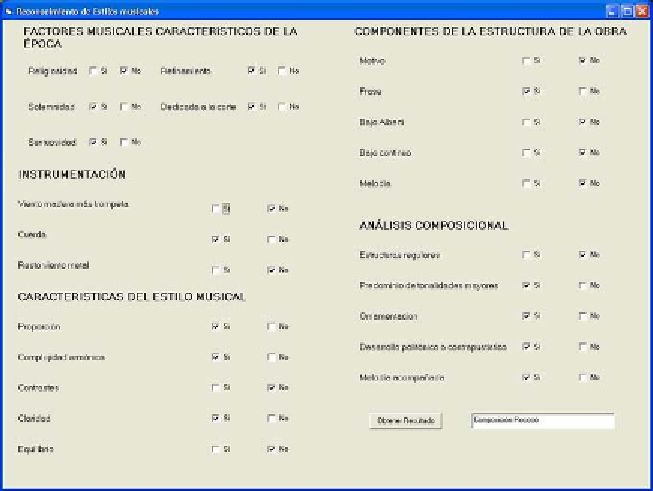Information Technology Reference
In-Depth Information
An expert teacher would probably use pieces
of music which have well-defined identifiers. In
a real session of practice with ES1, as advanced
in the introduction, subjectivity or lack of a mini-
mal knowledge of the meaning of the identifiers
may cause the user(s) to introduce inaccurate
identifiers.
as F1), it is solemn (potential fact denoted as
F2) and sumptuous (potential fact denoted as
F3). But it did sound neither exquisite (potential
fact denoted as F4N, that is not-F4) nor devoted
to a selected audience (potential fact denoted
as F5N, that is not-F5).
•
Instrumentation consisted fundamentally
of wood wind instruments plus trumpet
(potential fact denoted as F6).
First Example
•
Regarding characteristics of the musical
style, the user observed no proportion in
the execution (potential fact denoted as
F9N, that is, not-F9), while it did have har-
monic complexity (potential fact denoted
as F10) and significant contrasts (potential
fact denoted as F11). Nevertheless, neither
clearness (potential fact denoted as F12N,
that is not-F12) nor equilibrium (potential
fact denoted as F13N, that is not-F13).
We suppose that, during or after listening the first
score, a student or a group of students using ES1,
have distinguished, to the best of their knowl-
edge, the following set of 23 identifiers—that is,
a particular maximal consistent subset of the set
of the 23 + 23 potential facts.
Actually, in the first example we have con-
sidered “Concert in La Minor” for violin by J.S.
Bach.
•
Regarding the structure, presence of motif
is appreciated (potential fact denoted as
F14), but no phrase (potential fact denoted
as F15N, that is not-F15) neither Alberti bass
•
Regarding characterizing musical factors of
the epoch, the user observed that the sound has
certain religious flavor (potential fact denoted
Figure 4. Selection corresponding to a Rococo composition

Search WWH ::

Custom Search